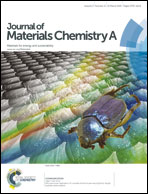Photoelectrochemical water splitting at low applied potential using a NiOOH coated codoped (Sn, Zr) α-Fe2O3 photoanode†
Abstract
One of the major challenges in photoelectrochemical water splitting is to develop an efficient photoanode that can oxidize water at low applied potential. Herein, a codoped (Sn, Zr) α-Fe2O3 photoanode modified with a stable and earth abundant nickel oxyhydroxide (NiOOH) co-catalyst that can split water at low applied potential is reported. First, an unintentional gradient monodoped (Sn) α-Fe2O3 photoanode was synthesized at controlled annealing temperature that achieved a photocurrent density of 0.86 mA cm−2 at 1.23 V vs. RHE. Further doping with an optimized amount of Zr outperformed the monodoped (Sn) α-Fe2O3 photoanode providing significantly much higher photocurrent density (1.34 mA cm−2). The remarkably improved electrical conductivity and more than three times higher charge carrier density (as evidenced from electrochemical impedance spectroscopy measurements and Mott–Schottky analysis) of the codoped (Sn, Zr) α-Fe2O3 photoanode highlight the importance of codoping. The synergetic effect of codoping (Sn, Zr) led to 1.6-fold enhancement in charge separation efficiency at 1.23 V compared to the monodoped (Sn) α-Fe2O3 photoanode. The NiOOH modified codoped (Sn, Zr) α-Fe2O3 photoanode exhibited drastically lower onset potential (0.58 V) and a photocurrent density of 1.64 mA cm−2 at 1.23 V. Interestingly a 160 mV cathodic shift in photocurrent onset potential was also observed. Concomitant with this, the NiOOH modified codoped (Sn, Zr) α-Fe2O3 photoanode exhibited 1.6 to 9.5-fold enhancement in charge injection efficiency (ηinj) at the kinetic control region of 0.7 to 0.9 V compared to the unmodified codoped photoanode. Gas evolution measurements also showed that the NiOOH modified codoped α-Fe2O3 photoanode achieved an average Faradaic efficiency of 93%.



 Please wait while we load your content...
Please wait while we load your content...